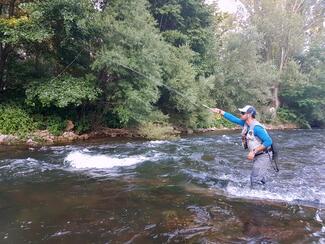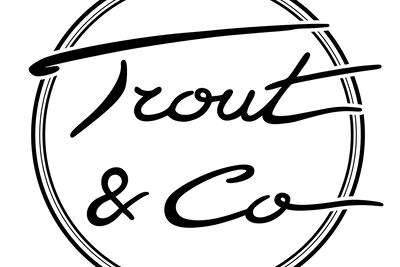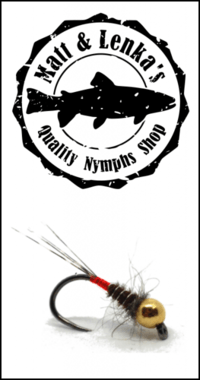Last time we went through the selection of the rod for euro nymphing. Now, let’s talk about how to build the line properly. If the leader’s configuration for dry fly fishing is an issue that attracted much attention, it seems that the debate isn’t ready to slow down on the nymphing side neither. Even though we don’t use the fly line in the modern euro nymphing techniques, the leader’s characteristics grant some properties that will inevitably affect the fishing. There are a wide range of options in the choice of the fly line used as well. Each and every one of them has its own pros and cons.
With the modern Euro nymphing techniques, every European country is attributed with its own way to do. In most of the countries, the fishermen develop a specific version of nymphing. It is common to hear about « Czech nymphing », « Spanish nymphing » or even “French nymphing”. Very often, the line building allows making a difference between them. We will put aside all those different spellings that only get people confused in order to focus on the different characteristics of each element playing an important role in the line’s construction and that is adapted to your practice. With euro nymphing, the line is made with the following:
- Main line
- Leader
- Indicator
- Tippet
Let’s see what they look like individually !
THE MAIN LINE
As we mentioned before in the “how to choose the rod” article, casting with the modern techniques consists in a unique wrist movement in order to power the weighted nymphs without any use of the fly line’s inertia. Because of that, the fly line is almost useless. A standard size fly line even becomes a handicap as soon as it reaches the tip of the rod. Any time you need to fish from a distance (from 5 to 6 m) it makes your line drag as soon as your nymphs touch the surface. You lose your natural drift before it even started, and this is more and more accurate with lighter weights.
To avoid this situation and fill up your reel, you have 3 solutions. Each one of them has pros and cons.
Spool your reel with nylon
It is a radical choice that is very popular in Spain and called "pesca al hilo". It allows to avoid the impact of fly line since you remove it for good. Usually, the reel is filled with fluorescent nylon (18/100 or 4X) on which the tippet is directly linked with a micro ring or a tiny loop. If we decide to use a neutral nylon in the reel, a short piece of fluorescent line is added as an indicator just before the tippet. This option allows making long natural drifts. The lightness of the 4X doesn’t influence the drift but if the rod blank is wet will not slide properly in the rod’s guides. Fly rods aren’t made to cast nylon in the first thing anyway. Furthermore, with that option, you can’t switch from nymphs to dry unless changing reel or reel spool at least.
So, if you decide to use this option.
Pros
- No impact from the line on the drift, even from a long distance and with light nymphs
- More sensibility in the blank
Cons
- The nylon twists
- Can be harder to cast for newbies
- Much harder to cast when rainy
- No adaptability (can’t use a dry fly if a fish is rising)
A standard fly line adapted to the rod’s power
As mentioned in our rod’s selection article, some nymphing rods are more versatile than others and have an excellent capacity to cast a fly line for dry fly fishing. For that, the CPM must be high and the PTE low, otherwise it ain’t work. Anyway, if you’re looking for something that allows you to change technique quickly while just changing your leader, this option is ideal. So if you spool your reel with a standard fly line (generally weight 2, 3 or 4) as long as it is adapted to your rod, you should be able to nymph and switch to dry any time you want.
While nymphing, you will have to make sure to build your tippet long enough to make sure that the fly line won’t get over the rod tip during the drift. Or you can also decide to fish closer and then avoid this situation and keep it within the guides. Furthermore, the stripping guide of the selected rod will need to be close to the handle (about 45 cm or 1,5 foot) in order to avoid the fly line’s impact on the drift, especially when your rod is high. A standard fly line will affect the drift and cause dragging if it’s weight pulls on the leader.
Summary for the use of a standard fly line.
Pros
- Perfect versatility
- No problem fishing under pouring rain
Cons
- Influence of the fly line on the drift while fishing far or with light weighted nymphs
- Risk that the fly line pulls down in the rod’s guides.
A very fine line type 0.55 mm
Those new products pop-in on the market after they’ve been allowed by the FIPS for international competitions that impose a minimum size of fly line. This solution is in between the 2 previous options. It is certainly interesting on a purely technique point of view. It allows a perfect glide even if the blank is wet because the fly line doesn’t stick. It also allows avoiding twisting and limits the influence of the fly line on the drift thanks to its light weight. Finally, a fine fly line is probably the kind of line the most enjoyable to manage and reel with the hand during the drift in order to control. But it is not adapted at all to cast a dry fly.
Pros
- Very light influence on the drift, even from far away
- Not sticky on the blank when wet
Cons
- No versatility unless changing spool or reel
THE LEADER
Exactly like for dry fly fishing, the leader for euro nymphing has 3 essential traits that you can adapt:
- The length
- The conicity
- The diameter
Let’s see how each and every one of them influence on the line’s behaviour.
The length
The leader’s length is the distance between the fly line end and the beginning of the tippet. The longer the leader is, the more natural the drift will be. But it is also harder to use. Indeed, a very long leader allows fishing from long distance (about 5 to 6 m with a 10’ rod) and the fly line wouldn’t past the tip of the rod. Thanks to that, it makes your drift drag free and natural. The only time you would need a short leader would be fishing from short distance in small waters, tight, with overhanging vegetation.
Whatever the length of the leader, we properly fish with euro nymphing technique only until moderate distance. The best distance is becoming shorter with a higher speed/depth ratio on the spot.
The main limit in the fishing is caused by the relatively short length of the rod used. There is no hope for doing a good, drag free, natural drift from more than 10 or 12m with a fly-fishing rod.
On the practice side, the length of leader that allows reaching the maximum fishable distance and keep the fly line within the rod’s guides is about 2 rod length (20 feet at least) including the tippet.
If using a 10’ rod (3m), the standard length for euro nymphing, a classic leader would be 20' including the tippet. So you would have about 15' (4.50m) without the tippet, which would allow fishing properly until roughly 7 to 8m. The angle between the rod and the line is by then around 90 degrees, as recommended.

However, a long leader doesn’t come only with advantages and specially for beginners : it takes some practice to be accurate with the casting. The good timing to block when back casting and the impulse forward (like if casting a dry fly) are essential requirements for accurate casting. It is also harder to manage if the conditions are windy. In this case, it is better the make it shorter.
The conicity
The conicity of the leader means the reduction of the nylon diameter between the base linked to the fly line and the final part attached to the indicator.
The more conic the leader is, the easier it is to direct it. Which means that it gives direction to your nymphs from the wrist when casting. It influences the presentation as well.
On the other hand, a leader built with only nylon doesn’t present any conicity. This leader is only good for people with a lot of experience in this type of fishing.
The conicity of the leader can be obtained by different ways.
- By making a decreasing knot leader
Decreasing can be for the diameter of the nylon and for the length of each part. Progressively decreasing either diameter or length will make the leader conic. Like for dry fly fishing, there is an infinity of possible ways to build a decreasing leader with formulas for each one of them.
- Using Knot-Free leader
They are usually 9 or 12’ long, starting from 50/100 (0X) and the tippet 18/100 (4X). It is by then possible to adapt it how you like it. Compared to the previous type of leader, the knot-free side makes the glide in the guides of the rod easier whether for casting or retrieving during the drift. The downside is that it cost much more money than if you built it yourself.
A conic leader allows fishing quickly than with a mono leader, which are much slower to deploy. An important conicity is very useful for tight spots. For example, when fishing a mountain creek with pocket water, you would definitely need the extra accuracy and speed to fish properly. The influence of the conicity is close to the influence of the length. Keep in mind that the more a leader is short and conic, the easier it is to direct it and to use it for beginners. In the other hand, the inertia of the nymphs at the need of a long unique nylon part without conicity requires much more amplitude to cast them. It is also much slower and you need a long stop during the back cast in order to send them forward. They find their best utility for fishing long pools because they are much more adapted to long drifts from far away.
In tight spots, where fisherman movements are limited, a knot leader is much easier to use. If the conditions are windy as well, a conic leader will be easier to cast with accuracy. Only experienced nymph fishermen can be accurate with a non-conic leader in tight areas.
The diameter
The diameter of the leader allows managing the degree of conicity (thanks to the difference between the thickest part and the finest).
For the same length, more the difference between the thick part and the fine one is high, the more conic and easier to use the leader will be.
A leader for beginners that is 4.50 m long (15’) from 0.018"(45/100) to 4X (18/100) is much easier to cast than one of the same length ending by 2X (25/100).
If fishing with only nylon in the reel, the diameter is a matter of compromise :
-
To thin will make it twist faster.
-
Too thick will make casting harder if using light weighted nymphs
2X (18/100) seems to be the ideal diameter to cast every size of nymphs and avoid twisting the nylon too quick.
Whatever the type of leader chosen, the fluorescent indicator that finishes it must be at least 18/100 in order to be visible. We will talk about this element and bring more details in another article focused on euro nymphing.
To summarize:
- A short and conic leader is easier to cast and more direct
- For long distance and light weighted nymphing, a long and fine leader is needed
On the practice side, Trout & Co recommendations are :
- To begin (in any type of water) the usage of a knot leader or knot free of 6m (18’) maximum is best.
- Same for short distance fishing
- For large rivers with standard weights, better use a long leader (at least 18' with tippet) with knots or mono
- For stealthy approach, light weights (bead head smaller than 2.8mm) the usage of a long leader with a mono part is best.
Tip : build a progressive knot leader (with increasing length between each part) allows keeping conicity if you decrease the thicker parts. It will make it lighter and reduce the influence on the drift.
Exceptions
In the case of euro nymphing with the line left dead on the water (used for long distances superior to 10 m), we can use the inertia of the fly line to cast the nymphs. The bead head size doesn’t exceed 2.8 mm in this case.
How to gain versatility
With all the above, some solutions are available to the fisherman that wants to switch between dry and nymphs:
- Carry two fly rods or two spools or two reels. Each one of them has a different fly line and leader dedicated to euro nymphing for one and dry fly for the other. For the nymphing side, mono nylon or ultra-fine fly line with long leader is the must. For the dry fly-fishing side, standard fly line and a decreasing leader are the best option. That is the optimum solution for the fishing quality.
- Use a fly line with adapted weight to the rod and add a versatile leader. For that, you can compromise the length (roughly 4.50m including tippet) in medium streams. It allows to only have to modify the tippet if you need to switch technique. Here is an example :
Length (cm): 80/60/50/40/30/20/20/20
Diameter (/100): 45/40/35/30/25/20/18/14 (indicator)
- Intermediary solution : use a fly line adapted to the rod’s weight and add a decreasing leader (about 3.50 m long) specifically built for dry fly fishing and ending with a micro loop. You will only have to link the tippet for needed for dry fly fishing. To switch for nymphing, to the Spanish way for example, you will only have to add a couple of metres of fluorescent nylon to this micro loop. With this leader, you’ll be able to properly use the euro nymphing techniques and quickly switch to a dry fly leader if fish start to feed on the surface and rise. By the way, if switching from the nymphing to the dry fly technique, you can keep the fluorescent section and use it again later.
Some examples of french nymphing leaders :
- Versatile beginner leader (11'5" without tippet)
Lenght (cm) : 75 / 65 / 55 / 45 / 80 / 35
Diameter (/100): 45 / 40 / 35 / 30 / 25 / 20 indicator
- Advanced angler leader (15' without tippet)
Lenght (cm) : 85 / 75 / 65 / 55 / 100 / 35
Diameter (/100): 45 / 40 / 35 / 30 / 25 / 20 indicator
- Expert angler leader (17'3" without tippet)
Lenght (cm) : 100 / 110 / 120 / 160 / 35
Diameter (/100): 30 / 25 / 22 / 18 / 18 indicator


